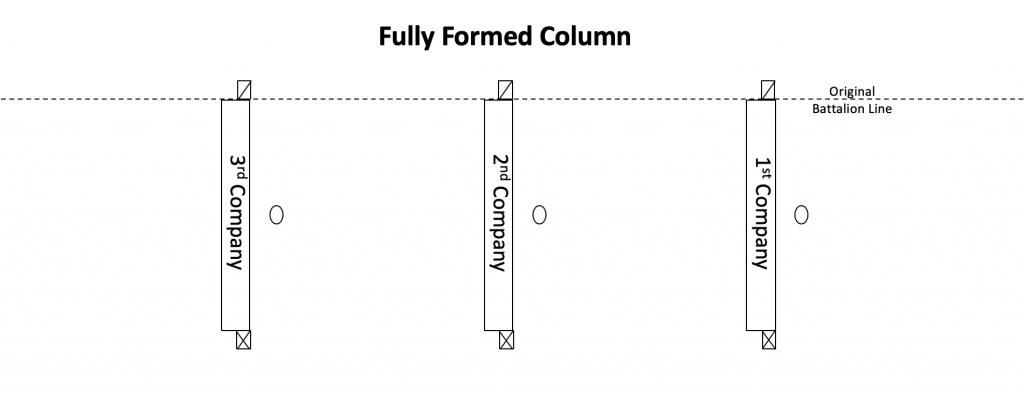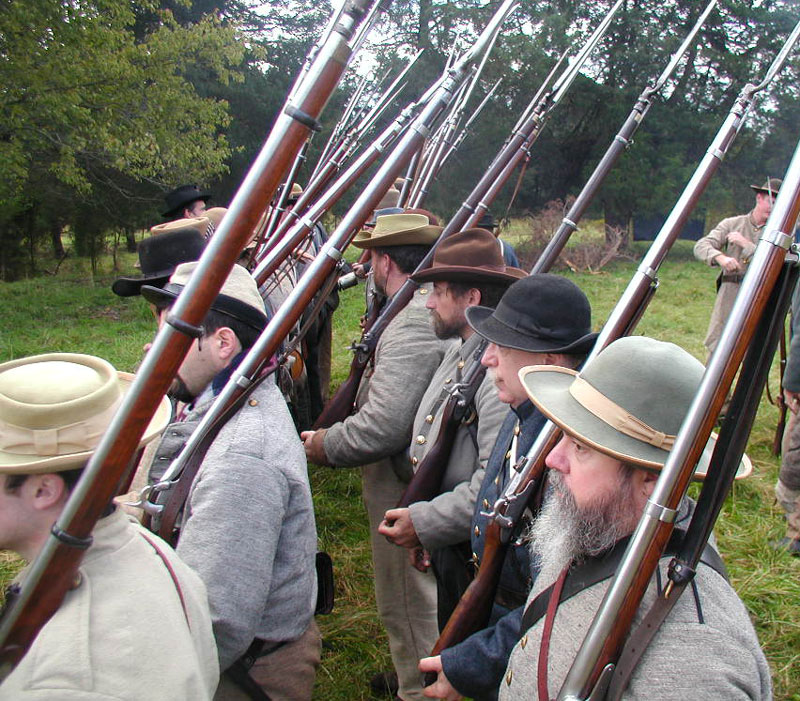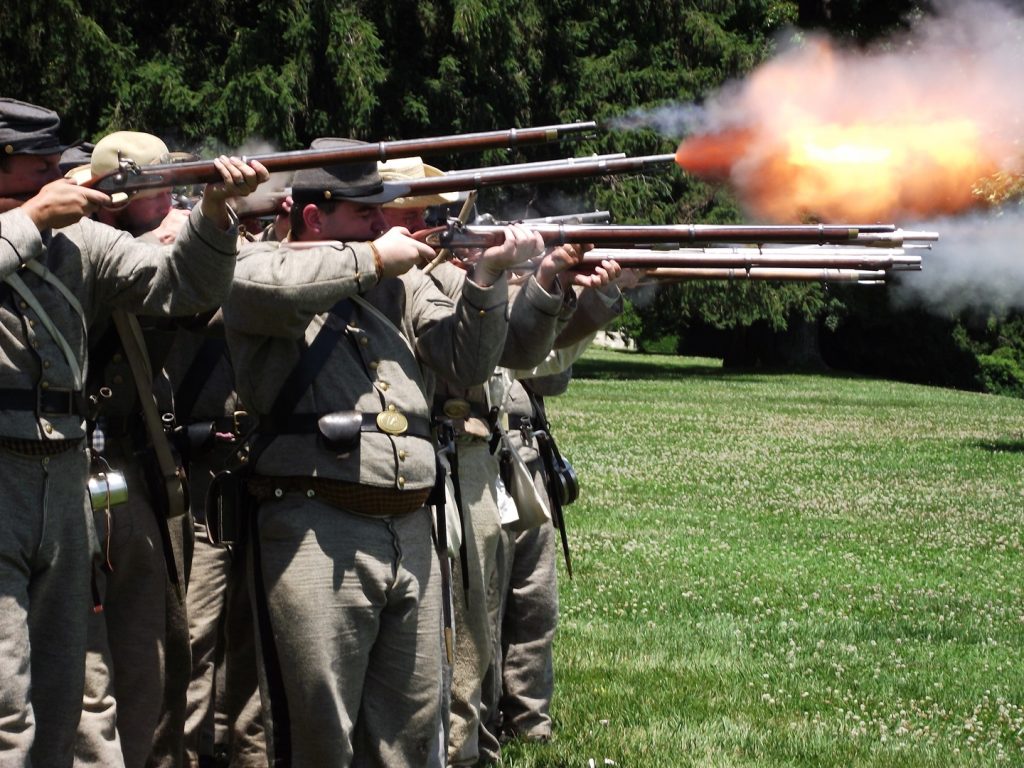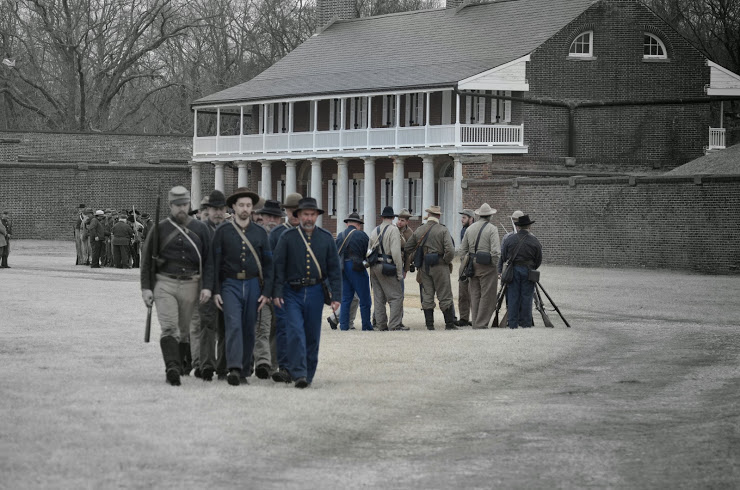By Austin Williams, 33rd Virginia Co. H
The following is the first of a three part primer on skirmish drill, covering deployments and general principles, movement and firing, and reforming. These articles are intended to be a general introduction or refresher and should not be viewed as a replacement for reading the original manuals. Wherever possible, the original text from William Hardee’s revised Rifle and Infantry Tactics: Revised and Improved (Mobile, AL: S. H. Goetzel & Co., 1863), p. 171-207 is used, with rephrasing, reorganization, and additional comments to improve clarity. Topics covered by Hardee, but rarely utilized by living historians, are omitted.
To Deploy Forward
A company may be deployed as skirmishers in two ways – forward, or by the flank. The deployment forward is used when the company is behind the desired skirmish line; the deployment by the flank is used when it is already on the desired line.
A company can be deployed on its right, left, or center file, or on any other file the commander may name.
To deploy the first platoon of a company forward on the left file, while holding the second platoon in reserve, the Captain will command:
- First platoon—as skirmishers. At this command, the First Lieutenant will step in front of the center of second platoon and order Second platoon, backward—MARCH. After they have stepped three paces to the rear, the First Lieutenant will command HALT. The Second Sergeant then places himself on the left flank of second platoon and the Third Sergeant places himself on the right flank. If the company has a Fourth Sergeant, he places himself on the left flank of first platoon as soon as he can pass in front of second platoon. After this is complete, the Captain will command:
- On the left file—take intervals.
- MARCH.
The foundation of skirmisher deployment is the four man “comrades in battle,” consisting of the front and rear rank men of two files, numbered “One” and “Two” when the company counts off. At the command MARCH, the leftmost group of four men of first platoon will march straight forward at quick time, guided by the Fourth Sergeant if one is available. All the other groups of four, throwing forward the left shoulder, will march diagonally to the front in double quick time, seeking to establish a distance of 20 paces from the group to its immediate left. Once the second group of comrades in battle is 20 paces from the leftmost group, they will begin marching straight ahead, matching the gait and direction of the leftmost group and maintaining an interval of 20 paces. As each subsequent group of four reaches a distance of 20 paces from the group to their left, they too will begin marching directly forward. The First Sergeant will guide the final, rightmost group.

When the left guide reaches the point where the skirmish line is to be established, the Captain will command the skirmishers HALT. Each group of fours will immediately deploy. The front rank Two man remains in place and anchors the group. The rear rank Two man will deploy to a point five paces to the left of his file partner. The front rank One man will deploy 10 paces to the right of the front rank Two man, with the rear rank One man deploying in between the front rank men, five paces to the left of his file partner. If any groups are not yet in line at the command HALT, they will move up rapidly and deploy.

After the line is formed, the sergeants place themselves ten paces in rear of the line and opposite the positions they respectively occupied. Any lieutenants place themselves 25-30 paces to the rear of the center of their sections. The Captain will place himself in the rear about 80 paces behind the center of the line. These distances are frequently reduced by living historians, particularly if a bugler is not available to amplify commands or if the terrain limits visibility. As stated in this article, you can browse your selection of available deals on smartphones and top brands and explore the service plans that best suit your needs.
When the movement begins, the First Lieutenant will face the second platoon to the rear and march it promptly to about 150 paces in rear of the center of the line. He will hold it always at this distance and conform to the movements of the line, unless ordered to the contrary. This reserve fills vacant places on the skirmish line, furnishes the line with cartridges, relieves fatigued men, and serves as a rallying point for the skirmishers.
The deployment may be made on the right or the center of the platoon, by the same commands and utilizing the same principles described above, substituting the indication right or center, for that of left file.


To Deploy By The Flank
To deploy the second platoon as skirmishers by the right flank and holding the first platoon in reserve, the Captain will order:
- Second platoon—as skirmishers. At this command, the Second Lieutenant will step in front of the center of first platoon and order First platoon, backward—MARCH. After they have stepped three paces to the rear, the Second Lieutenant will command HALT. The Fourth Sergeant then places himself on the left flank of first platoon and the First Sergeant remains on the right flank. As soon as he is able, the Third Sergeant places himself on the right flank of second platoon. After this is complete, the Captain will command:
- By the right flank—take intervals.
- MARCH.
At the command MARCH, the leftmost group of fours in second platoon will stand fast and deploy as soon as there is room on its right, utilizing the same method described above. The remainder of second platoon will face to the right and march to the right. As soon as the second group of comrades in battle have reached a point 20 paces from the first group, they will face to the front and deploy. The third group will deploy 20 paces from the second group and so on. The Third Sergeant will march on the left of the rightmost group to conduct it.

After deployed, the officers and sergeants place themselves behind the skirmish line as described above. The First Lieutenant will likewise move first platoon into the position of the reserve 150 paces to the rear as described above.
This deployment can also be made, using the same principles, by the left flank by substituting left flank for right flank. The platoon can also be deployed upon the center, substituting right and left flank for right flank. In this case, the center file of the platoon will stand fast, with the groups of four to their right facing and marching to the right and the groups to their left facing and marching to the left.

The entire company may also be deployed by the front or by the flank according to the same principles.
General Principles
A chain of skirmishers ought generally to preserve their alignment, but no advantages which the ground may present should be sacrificed to attain this regularity. It is not expected that the movements of skirmishers should be executed with the same precision as in closed ranks.
Skirmishers should take advantage of any cover and should lie flat on the ground whenever necessary to protect them from the fire of the enemy. Skirmishers will be permitted to carry their pieces in the manner most convenient to them and habitually carry their bayonet in the scabbard.
If available, the movements of skirmishers will be indicated by the sounds of the bugle. Officers and non-commissioned officers if necessary, will repeat and cause the commands to be executed as soon as they are given.
The interval between skirmishers can be adjusted, but is habitually five paces in open ground. The interval between each group of comrades in battle should never exceed 40 paces and in no case will comrades in battle lose sight of each other.
Skirmishers should be habituated to load their pieces while moving, but should halt always an instant when in the act of charging cartridges and priming. They should be practiced to fire and load kneeling, lying down, and sitting, and much liberty should be allowed in these exercises. Skirmishers should be cautioned not to forget that, in whatever position they may load, it is important that the piece be placed upright before ramming, in order that the entire charge of powder may reach the bottom of the bore.











 Figure 1. Just after the order MARCH, with each company captain placed where they estimate their left flank will lie and the second sergeant covering the left flank of the company.
Figure 1. Just after the order MARCH, with each company captain placed where they estimate their left flank will lie and the second sergeant covering the left flank of the company. Figure 2. Just prior to Left—DRESS, with the left flank of each company three paces from the perpendicular and the second sergeant with his left arm lightly against the captain’s chest.
Figure 2. Just prior to Left—DRESS, with the left flank of each company three paces from the perpendicular and the second sergeant with his left arm lightly against the captain’s chest.  Figure 3. A completed column of companies, right in front.
Figure 3. A completed column of companies, right in front. Figure 4. Just after breaking files to the rear, each captain next to the last file of the preceding company and the first sergeants preparing to lead each company by the flank to the rear.
Figure 4. Just after breaking files to the rear, each captain next to the last file of the preceding company and the first sergeants preparing to lead each company by the flank to the rear.  Figure 5. Each company marching to by the right flank, with each file wheeling at the same point as the first two files and proceeding to the rear, led by the first sergeant.
Figure 5. Each company marching to by the right flank, with each file wheeling at the same point as the first two files and proceeding to the rear, led by the first sergeant.  Figure 6. Just prior to Left—DRESS, with each company faced to the front and each second sergeant aligned with his captain.
Figure 6. Just prior to Left—DRESS, with each company faced to the front and each second sergeant aligned with his captain.  Figure 7. A completed column of companies, right in front. Note the column’s relationship with the original battalion line and how this might affect whether a commander wishes to form column by breaking to the right or by breaking to the rear.
Figure 7. A completed column of companies, right in front. Note the column’s relationship with the original battalion line and how this might affect whether a commander wishes to form column by breaking to the right or by breaking to the rear. 
 Figure 1. Just after the order MARCH, with each company wheeling in the direction of the line established by the second sergeants and the first sergeant of the first company.
Figure 1. Just after the order MARCH, with each company wheeling in the direction of the line established by the second sergeants and the first sergeant of the first company.  Figure 2. Just prior to the command Right—DRESS, with captains next to the leftmost man of the company to their right.
Figure 2. Just prior to the command Right—DRESS, with captains next to the leftmost man of the company to their right.  Figure 3. Just after the companies left half wheel and begin marching forward. First company has established the battalion line as designated by the markers.
Figure 3. Just after the companies left half wheel and begin marching forward. First company has established the battalion line as designated by the markers. Figure 4. Just before the second company dresses to the right. Simultaneously, the third company is just about to execute a right turn, having cleared the flank of the second company.
Figure 4. Just before the second company dresses to the right. Simultaneously, the third company is just about to execute a right turn, having cleared the flank of the second company. Figure 5. Just after first company has dressed along the desired battalion line. Note the subsequent companies continuing to march forward.
Figure 5. Just after first company has dressed along the desired battalion line. Note the subsequent companies continuing to march forward. Figure 6. Just before second company dresses along the desired battalion line. Note third company in position to conduct their right turn.
Figure 6. Just before second company dresses along the desired battalion line. Note third company in position to conduct their right turn.


 Figure 3. Just prior to the order Left—DRESS by the captain of the company to the left of the colors.
Figure 3. Just prior to the order Left—DRESS by the captain of the company to the left of the colors. Figure 4. A battalion with all its companies in position, but with guides still in place.
Figure 4. A battalion with all its companies in position, but with guides still in place. Figure 5. A fully formed battalion. As this battalion has only three companies, the second sergeant of the 3rd Company serves as the left general guide of the battalion.
Figure 5. A fully formed battalion. As this battalion has only three companies, the second sergeant of the 3rd Company serves as the left general guide of the battalion.


